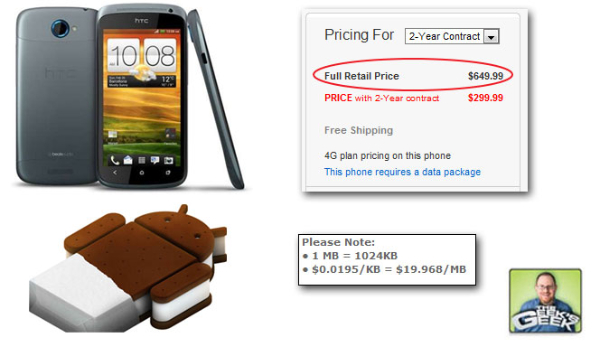The 7 Worst Smartphone Injustices and How to Fight Them
Don't be a mobile martyr. Avoid the worst crimes carried out by phone vendors and carriers, like non-removable batteries and predatory pricing.

“Injustice in the end produces independence,” Voltaire wrote. For their part, smartphone users must endure a litany of injustices, ranging from endless contracts that tie them to outdated hardware to phones that run out of juice by noon.
Unfortunately, we’ve become so inured to the injuries that we hardly notice when phone vendors and carriers hit us with yet another body blow. Fortunately, you don’t have to be a mobile martyr. Here are the seven most malicious forms of telephone tyranny and the best ways to fight them.
1. Sealed Batteries, Weak Battery Life
If you love being infantalized, some of today’s top smartphone vendors are waiting for you with a pair of high-definition diapers and an LTE pacifier. Rather than giving you the choice of whether or not to replace their low-capacity batteries with slightly-thicker, high-capacity units, more and more smartphone manufacturers are using sealed, non-removable batteries.
Even worse, most of the non-removable-battery phones have very pedestrian battery lives. The Droid 4 might be the world’s best keyboarded phone, but its 1785 mAH battery limits it to just 5 and half hours of continuous use and, if you don’t like that, Motorola has a message for you: “tough touch screens.” HTC must feel the same way, because all three of its upcoming “One” series phones have sealed in batteries, even though none exceeds the pedestrian 1800 mAH capacity.
The Droid RAZR Maxx has a sealed battery, but gets over 8 hours of endurance because that battery is an impressive 3300 mAH. However, should the RAZR Maxx’s battery lose its ability to hold a full charge, you’re out of luck. On the flip side, Samsung’s Galaxy Nexus lasts under 4 hours on a charge, but you can replace its battery with one that’s double the capacity.
The excuse for this paternalistic practice is that providing a battery door and the space to stick your finger in and pop the existing battery might add a millimeter or two to the phone chassis. How many millimeters is your freedom worth?
How to Fight the Sealed Battery Injustice: Only buy phones with user-removable batteries. If you already own a sealed-battery phone, you’ll need an external battery like the New Trent iFuel.
MORE: Smartphones With the Longest Battery Life
2. 20-Month Wait Between Phone Upgrades
To get a good smartphone at a decent price, you usually need to agree to a two-year contract, but what happens 6 months into that contract when your phone is eons out of date and you want to upgrade it? In Spring 2011, the HTC Thunderbolt was Verizon’s hottest phone, because it was the first with LTE. By fall, the single-core, low-res screened handset looked like a joke next to high-res speed demons like the Droid RAZR and HTC Rezound.
The three largest U.S. carriers each make you wait 20 months to get a replacement at subsidized prices (less than $500 or so) by which time your current phone will be ready to take its place in a museum. T-Mobile offers “early upgrade pricing” after 12 months that’s not as favorable as a subsidized rate but gives you some discount off of the retail price. After 22 months, T-Mobile subscribers on two year contracts are eligible for a fully-subsidized upgrade.
How to Fight the 20-month Upgrade Injustice: It’s hard to get a phone at the two-year subsidized price sooner than 20 months into your contract, but there are ways to save. First, try calling your carrier and see if you can negotiate for an early upgrade, because occasionally company reps will give long-time customers a break. T-Mobile users can take advantage of early upgrade pricing, and anyone can buy an unlocked phone through a third-party vendor that offers a bit lower retail pricing than the carrier.
3. Pay Extra for Tethering
It’s not enough for carriers to charge you $30 or more for a smartphone data plan. They make you pay another $30 or so to share that data with your notebook or tablet. What the heck? If major home ISPs like Time Warner Cable or Comcast tried to charge you separately for every device that connects to your router, there’d be an “occupy the customer service department” movement.
How to Fight the Tethering Premium Injustice: Fortunately, there are ways around the fees, if you’re willing to cheat a bit and use a wired tethering app like PdaNet or a wireless hotspot app like Barnicle WiFi Tether, the latter of which requires you to root your phone.
4. Lose Your Smartphone, Lose Your Shirt
Yesterday, you bought a new smartphone for $99, but this morning you left it in a cab. Buying a replacement will cost a hefty $550 and you don’t have much choice in the matter, because you’re under contract for the next 24 months and the early termination fees are too expensive to let you walk away.
Your carrier may offer you a phone insurance plan at the time of purchase, but it probably won’t be a good deal. For example, Verizon’s Total Equipment Coverage plan promises only a “comparable model” to your phone, says that the replacement device may be refurbished, and charges a $99 deductible on any claims in addition to a $6.99 monthly fee ($168 over 24 months). Unless you’ve had a psychic vision of yourself dropping the phone into a sewer, you’d be better off not buying this kind of half-hearted, but full-priced protection.
It’s understandable that carriers would charge you a somewhat higher price to replace a lost phone, because they take a loss on every handset they sell at subsidized prices. However, I can’t help but think that the full retail prices they charge you are jacked up, because they know you have no choice but to pay them. Unfortunately, wholesale pricing for smartphones isn’t normally made public, but it’s hard to believe Verizon pays anywhere close to $649 for the Samsung Galaxy Nexus.
How to Fight the Lost Phone Pricing Injustice: As I suggested in the “early upgrades” section above, you can try to negotiate with your carrier for a discount or turn to third-party sellers on sites like eBay. For example, on eBay, you can purchase an unlocked Samsung Galaxy Nexus for $500, $150 less than Verizon’s $640 retail price. You can also get a used model for as little as $350.
MORE: A Comparison of Cellphone Insurance Plans
5. Disinterested Carriers, Vendors Don’t Issue OS Updates
Imagine depending on Best Buy, where you bought your Pavilion dm4 notebook in 2011, rather than Microsoft to issue all your Windows updates. That’s the kind of lunacy Android and Windows Phone users have to face today, because they’re dependent on the kindness of their carriers for critical OS updates, even if they involve security breaches.
So, if Sprint CEO Dan Hesse has a bad day and decides that HTC Evo 4G users shouldn’t get Ice Cream Sandwich or AT&T’s Ralph De La Vega doesn’t want Windows Phone users to get the coming update that allows them to attach multiple photos to the same SMS message (therefore sending fewer texts), that’s their prerogative.
Unfortunately, there’s no strong business incentive for the carriers or manufacturers to issue such upgrades. The carriers already have your money and a two-year commitment for you to keep paying them every month, with or without updates. Smartphone vendors consider the carriers — not you — to be their clients. And the carriers couldn’t care less about spending money to support people who already bought their products.
When your phone is still running Android 2.1 while the latest handsets have 4.0, you might swear under your breath and vow to change wireless services or phone brands when your contract is up, but since they all do the same thing and churn rates are very low, they know you’ll be back.
Apple issues its iOS updates directly to all of its phones at the same time. Why can’t Google and Microsoft follow its example?
How to Fight the Slow OS Update / No OS Update Injustice: If you have an Android smartphone, you can probably find instructions on how to root it and install a custom ROM with the latest OS (Ice Cream Sandwich) at the XDA Developer’s Forum or a tutorial site like The Unlockr.
6. Out-of-Control Texting Rates
Most carriers charge $30 for 2 or 3GB of data, but 20 cents for each tiny, 160-character text message if you go over your allotment or aren’t on a pricey unlimited SMS plan. Different experts estimate this 20-cent price is a markup of 4,900 to 7,300 percent on something that has almost no cost to the provider. After all, the amount of data per message is so tiny. The worst part of paying per message is that anyone can spam you with SMS messages and make you pay for them against your will.
How to Fight the Outrageous SMS Fee Injustice: Users can log in to instant messaging apps like Google Voice to avoid paying SMS fees, but then they have to give out a second phone number just for texting. Instant messaging apps like Google Talk or eBuddy also fit the bill but gulp battery like there’s no tomorrow and require your friends to also be logged in for you to talk to them.
MORE: The Best Messaging Apps
7. Surfing the Web in a Foreign Country Costs More than Flying There
Though many U.S. carriers offer phones that are capable of getting a signal when you travel abroad, the price of such service is nuts, frequently costing as much as $20 per megabyte of data. Even so-called “affordable” packages like AT&T’s $24.99 for 50MB of monthly global data (with $1 per MB overage) are incredible rip-offs. Download a PowerPoint presentation to show a client in Europe or view the last day’s worth of email and you may end up paying hundreds of dollars before you even know what hit you.
Meanwhile, the cost of buying a local prepaid data plan in many countries is far less than you pay in the U.S. When I visited Spain earlier this year, I was able to purchase a prepaid SIM card on the Orange network with a week’s worth of unlimited data for just 9 Euros (around $12). Are you telling me that U.S. carriers can’t get a similar deal on data for its customers? No doubt AT&T, T-Mobile, and Verizon are paying foreign carriers even less than I paid on my own, but they’re marking up the cost per megabyte to unfathomable rates.
How to Fight the Outrageous Data Roaming Rate Injustice: Unfortunately for consumers, it’s not always easy to get your carrier to unlock your smartphone so you can buy a SIM from a local carrier. The best bet for frequent travelers may be to buy an unlocked phone.
If you don’t need to make voice calls on your smartphone, renting a mobile hotspot from Xcom Global might be your ideal solution. The company charges just $15 a day for a portable 3G MiFi that comes with unlimited Internet access on a leading network in whatever country you’re visiting. When carrying the MiFi in your bag, you can use it to get the Internet on your phone, laptop and tablet, all at the same time.
Sign up to get the BEST of Tom's Guide direct to your inbox.
Get instant access to breaking news, the hottest reviews, great deals and helpful tips.
